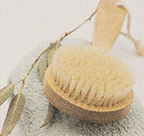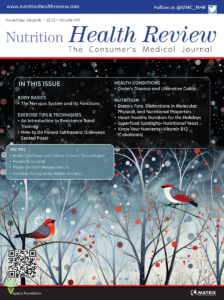 Skin brushing or dry brushing is the act of routinely brushing the skin all over the body using a special firm-bristled brush.1–3 While this practice is believed to have originated in Ayurvedic medicine thousands of years ago, skin brushing has had a resurgence in the last decade.1 But, before you grab a brush and start scrubbing away, it’s important to understand what this practice is, how to do it correctly, and its potential risks and benefits.
Skin brushing or dry brushing is the act of routinely brushing the skin all over the body using a special firm-bristled brush.1–3 While this practice is believed to have originated in Ayurvedic medicine thousands of years ago, skin brushing has had a resurgence in the last decade.1 But, before you grab a brush and start scrubbing away, it’s important to understand what this practice is, how to do it correctly, and its potential risks and benefits.
Where’s the Science?
The internet is replete with articles touting the potential benefits of dry brushing your skin; however, there is very little scientific evidence to back up many of these claims, outside of anecdotal reports. Here are some common claims, along with any supporting evidence (if available).
Fact or fiction—It exfoliates your skin. This claim is potentially factual. Exfoliation is the process of removing dead skin cells from the outer layer of your skin. While scientific evidence is scarce, there is some anecdotal evidence that dry brushing can be an effective, gentle form of physical exfoliation if your brush has soft enough bristles, your technique is gentle, and you’re not doing it more than twice each week (though no one can seem to really agree on how often skin brushing should be done [i.e., Cleveland Clinic says it can be done daily, though other sources recommend twice weekly]).3,7,9,10 Dry brushing can buff away dull, rough, flaky, dead skin cells, leaving the skin feeling smoother and softer and looking brighter.
Fact or fiction—It reduces cellulite. There is no research supporting the claim that dry skin brushing will reduce cellulite, so this claim gets thrown in the Fiction Bucket. However, while skin brushing does not get rid of cellulite, it may offer that as a temporary illusion: this is because skin brushing appears to increase circulation, which can plump up the skin and makes it look more radiant. Skin brushing may make cellulite look less noticeable temporarily, but it will not actually reduce cellulite.2
Fact or Fiction: It is gentler on your skin than a hot shower. This could potentially be true. Showers may help relax your muscles and soothe sore spots, but hot water can dry your skin by washing away its moisturizing oils, fats, and proteins, which may result in redness and itching.10 Dry brushing, on the other hand, is done without heat, water, or soap, so it could remove dead skin cells without stripping away the skin’s natural oils. The caveat here is that skin brushing, when done too vigorously, too often, or on particularly sensitive or fragile skin, can irritate and/or injure skin.
Fact or Fiction: It can help detox your body. Fiction! Some claim that skin brushing will boost the drainage of lymphatic fluids, supposedly helping to flush toxins from the body.3 However, there is no evidence to support this claim. A healthy human body handles detoxification perfectly fine all by itself using its liver and kidneys. In short, detoxification can only happen from the inside out, not outside in.2,3,6
Fact or Fiction: It offers a moment of self-care. This could potentially be true. While there is no available research specifically supporting this, it makes sense that dry brushing may offer some people a quiet moment to clear their minds and connect with their bodies. The smooth, gentle motion of the brush may help soothe anxiety and slow down breathing.11
Who Should Skin Brush?
While dry brushing is an easily accessible self-care activity, it is not suitable for everyone. In general, exfoliation should be done with caution. In individuals with certain skin conditions, such as eczema or psoriasis, or for those with thin, fragile skin, dry brushing may exacerbate their skin condition, increase irritation and inflammation, or cause skin tears. Additionally, skin brushing should not be done on injured skin (e.g., unhealed wounds, skin infections, burns).1,4 This also applies to people who have sensitive skin. Some dermatologists even say that exfoliation isn’t necessary because, just as the liver and kidneys can effectively remove toxins from the body without the need for outside assistance, the skin naturally sheds dead skin cells on its own roughly every four weeks, though this process can take longer as we age.12 If you do choose to exfoliate your skin with dry brushing or some other mechanical method, some dermatologists recommend that the exfoliation be limited to your arms and legs. As such, for some people, it would be prudent to consult with a licensed healthcare provider to see if skin brushing is right for you.
How to Skin Brush
Skin brushing is often called “dry” brushing because both the skin and the brush are completely dry during the process.4 The generally accepted method of skin brushing is as follows:
- Use a natural bristled brush. (Editor’s note: There are a number of natural bristled brushes specifically designed for body brushing on the market. A simple Google search will provide you with an ample selection of body brushes and information on where to purchase them).
- Starting at the feet or ankles, work your way upward, brushing your skin in long, fluid strokes on your arms and legs.
- Next, move the brush in a circular motion on your torso and back. Keep the pressure light on sensitive areas, such as breasts, abdomen, and neck.
- You only need to do a few overlapping swipes per area. Going over the same area for too long can cause irritation or bleeding.
- A shower is recommended immediately afterward, but avoid making the water too hot.
- If desired, apply a moisturizer to the exfoliated areas to help maintain moisture in the skin.2,5,10
Tips for Skin Brushing
- Dry brushing your skin should not take more than five minutes, even if you are covering your entire body. If your skin turns red, bleeds, or becomes inflamed, you should stop immediately.4,7
- Avoid brushing over the same area of your skin multiple times. This extra friction can cause irritation.2
- Showering after skin brushing is recommended. The idea being that you can wash away any dead cells remaining on your skin.
- Pressure is key. You should never use intense pressure while brushing your skin, but areas with thicker skin, such as the bottom of your feet, may be brushed harder than more sensitive areas, like the back of your hands.
- Though your skin is your body’s biggest organ, it is still very sensitive. Too much exfoliation, especially on your face, can result in tightness, shininess, stinging, redness, and increased sensitivity.12 Many experts recommend using mild exfoliants on your face, such as gentle facial scrubs or cotton rounds, if any at all.
- Be consistent with your routine and have realistic expectations. Seeing an improvement in texture, tone, or brightness can take weeks to months of regular brushing.12
Bottom Line
While there’s little scientific evidence to support the use of dry brushing in skin health, there is some anecdotal evidence supporting its use as an exfoliator. Additionally, some people may find skin brushing to be a soothing, relaxing activity. If your skin is healthy, skin brushing, if done correctly, most likely won’t do any harm, and possibly may offer benefits.
Editor’s note. Please consult with a licensed healthcare professional to address any questions or concerns you have regarding your health.
Sources
1. Heid M. You asked: should I dry brush my skin? 25 Mar 2015. Time Magazine website. https://time.com/3756761/dry-brushing-skin/. Accessed 9 Nov 2021.
2. Palmer A. Dry brushing the skin. 12 Sep 2021. Verywell Health website. https://www.verywellhealth.com/dry-brushing-the-skin-4177763. Accessed 9 Nov 2021.
3. Sinrich J. Here’s what dry brushing your skin actually does—and doesn’t do. 27 Aug 2018. SELF website. https://www.self.com/story/what-dry-brushing-your-skin-actually-does. Accessed 9 Nov 2021.
4. Flinn A. Dry brushing 101: everything you need to know for glowing skin. 18 Oct 2021. Byrdie website. https://www.byrdie.com/dry-brushing-body. Accessed 9 Nov 2021.
5. Robin M, Devine C. 12 Jun 2020. Dry brushing is a popular body treatment, but does it actually do anything? Allure website. https://www.allure.com/story/dry-brushing-benefits. Accessed 9 Nov 2021.
6. Gordon R. The benefits and risks of dry brushing. Updated 29 Sep 2017. Healthline website. https://www.healthline.com/health/dry-brushing. Accessed 9 Nov 2021.
7. Tang WS. Updated 3 Jan 2019. Are you dry brushing yet? How to get the most out of this age-old beauty routine. Canadian Broadcasting Corporation website. https://www.cbc.ca/life/style/are-you-dry-brushing-yet-how-to-get-the-most-out-of-this-age-old-beauty-routine-1.4965092. Accessed 9 Nov 2021.
8. American Academy of Dermatology site. How to safely exfoliate at home. https://www.aad.org/public/everyday-care/skin-care-secrets/routine/safely-exfoliate-at-home. Accessed 9 Nov 2021.
9. Engler A. Dry brushing: a step-by-step guide + the 3 best skin benefits. 29 June 2020. MBGLifestyle webite. https://www.mindbodygreen.com/0-12675/a-stepbystep-guide-to-dry-skin-brushing.html. Accessed 9 Nov 2021.
10. Cleveland Clinic site. The truth about dry brushing and what it does for you. 2 Nov 2021. https://health.clevelandclinic.org/the-truth-about-dry-brushing-and-what-it-does-for-you/. Accessed 9 Nov 2021.
11. Field T. Massage therapy research review. Complement Ther Clin Pract. 2014;20(4):224-229.
12. Mandall J. Exfoliating isn’t necessary but if you do it, follow the tips from these dermatologists. Updated 12 Apr 2021. Washington Post website. https://www.washingtonpost.com/lifestyle/wellness/exfoliate-skin-toner-scrub- dermatology/2021/04/11/ 2541d818-97ce-11eb-962b-78c1d8228819_ story.html. Accessed 9 Nov 2021.





